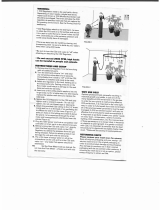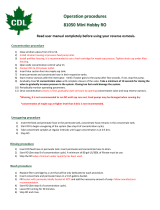PART SPECIFICATION
C1 Permeate tank, 500 L external on stand, black plastic
C2 Hydrophore, flowthrough, 8 L
D Drain pipe, 3/4" RG
F1 Filter 20", 5 µm
F2 Sterile breathing filter 0,2 µm
F3 Suction filter
G2 Pressure gauge, inlet pressure RO pump 0-10 bars
G3 Pressure gauge, RO pump pressure 0-10 bars
G4 Pressure gauge, 0-10 bars
K1 Check valve 16 bar, back pressure max 0,1 bar
K4 Check valve
M1/P1 RO pump
M2/P2 Feed pump
MV1 ON/OFF valve, 0-10 bars
MV2 Valve for flushing at start-up
MV3 Valve for membrane flushing
MV7 ON/OFF valve
PS1 Pressure switch, pre-adjusted to 0.5 bar
PS2 Pressure switch, type CS
RO1-3 RO membrane in stainless steel housing
US Ultra sound level sensor
V1 Test water tap 1/8“
V2 Ball valve for pressure adjustment
V3 Needle valve for concentrate outlet adjustment
V8 Ball valve
V9 Ball valve
WM Water meter for permeate
CO
2
option
CO2 (Option) CO
2
container
MV8 (Option) Valve for CO
2
R3 (Option) CO
2
pressure regulator
CIP option
C3 (Option) CIP container, 1 L plastic bottle
P3 (Option) CIP pump
EC REG 8 option
EC1 (Option) Conductivity sensor
EC2 (Option) Conductivity sensor
EC4 (Option) Conductivity sensor
F4 (Option) Filter, 5" 5 µ
F5 (Option) Mixbed, ion exchange bottle (Acquired locally)
F6 (Option) Mixbed, ion exchange bottle (Acquired locally)
K2 (Option) Check valve
K3 (Option) Check valve
EC option
EC (Option) Conductivity sensor
PO option
PO (Option) Pulse output for water meter
Misc. options
MV6 (Option) Valve for raw water mix, 0-10 bars
UV (Option) UV system
V5 (Option) Needle valve
ML RO 800
FD045GB-06
04.01.2017
LAA/KK
Parts list
Piping & Instrumentation Diagram























